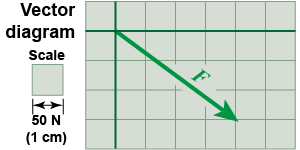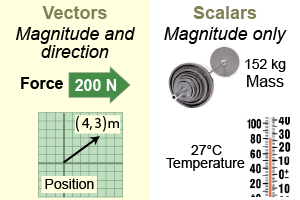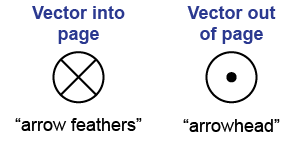|
Suppose someone told you to push a box with a force of 200 N (about 45 lb). What do you do? A moment’s thought and you realize that you need to know what direction to push or pull. Do you lift the box (upwards force) or push it to the left, right, forward, or backward? Force is a vector because a complete description of a force includes both strength and direction. This section describes the force vector and also the mathematics for how vectors are used to solve two- and three-dimensional problems that involve direction as well as strength. 
|
Properties of vectors and scalars
|
A vector is a type of variable that includes information that indicates direction as well as strength or size. Directional words such as “left” or “up” are fine for conversation, but until they are expressed as vectors they are not that useful in solving complex problems, such as navigating a robot vehicle. A vector includes direction information in very specific mathematical terms so that vectors in different directions can be added, subtracted, or multiplied. Directional information for a vector is specified very precisely compared to our typical descriptions of direction in everyday conversation. 
|
 A vector diagram is a type of graph in which the perpendicular axes represent the x- and y-directions the vector can have. When representing force vectors, the scale of the diagram relates length on the graph to the strength of the force. For example, suppose we choose a scale of 1 cm = 50 N. A 250 N force to the right is represented as an arrow starting at the origin and extending to the right with a length of 5 cm. A 250 N upward force has a length of 5 cm pointing up along the y-axis. The arrowhead points in the direction of the force.
A vector diagram is a type of graph in which the perpendicular axes represent the x- and y-directions the vector can have. When representing force vectors, the scale of the diagram relates length on the graph to the strength of the force. For example, suppose we choose a scale of 1 cm = 50 N. A 250 N force to the right is represented as an arrow starting at the origin and extending to the right with a length of 5 cm. A 250 N upward force has a length of 5 cm pointing up along the y-axis. The arrowhead points in the direction of the force. 
|
The magnitude of a force vector is its “length” on the diagram—or, equivalently, the strength of the force in newtons. The force vector in the example below has a magnitude of 200 N and points in the +x direction, whereas the displacement vector shown has a length of 5 units and therefore a magnitude of 5 m. The magnitude of a vector can either be zero or have a positive value, such as 200 N or 5 m. Magnitude cannot be negative. 
|
 As you learned on page 71, vectors are different types of variables from scalars. A scalar, such as mass or temperature, does not depend on direction and can be completely specified with a single value. A vector always includes direction and usually requires more than one value to describe it. To differentiate between the two types of variables, vectors are often written with a small arrow over them, such as .
As you learned on page 71, vectors are different types of variables from scalars. A scalar, such as mass or temperature, does not depend on direction and can be completely specified with a single value. A vector always includes direction and usually requires more than one value to describe it. To differentiate between the two types of variables, vectors are often written with a small arrow over them, such as . 
 |
Variables without an arrow are usually scalars. Some variables have both scalar and vector forms! For example, in an equation, is the force vector and F is the magnitude of the force, which is a scalar. We say “usually” because force is always a vector. In one-dimensional problems we allow F to have negative values, such as −200 N to represent forces in the negative direction. The little arrow may be omitted in such problems, reserving it for situations where two or three dimensions must be explicitly used. 
|
 When a vector quantity, such as force , is directed into or out of the page, the symbols at right are used to denote its direction. These symbols use the “arrow” metaphor: A vector coming out of the page looks like an arrowhead, while a vector going into the page looks like the crossed feathers at the end of an arrow.
When a vector quantity, such as force , is directed into or out of the page, the symbols at right are used to denote its direction. These symbols use the “arrow” metaphor: A vector coming out of the page looks like an arrowhead, while a vector going into the page looks like the crossed feathers at the end of an arrow. 
|

